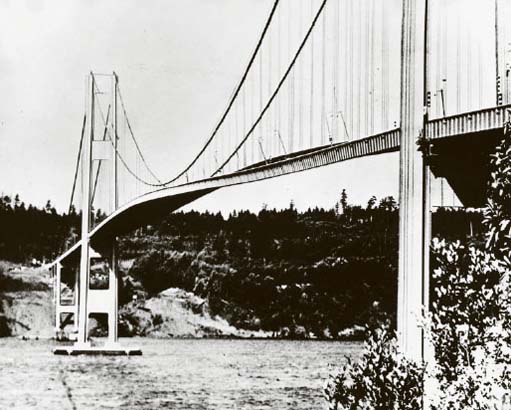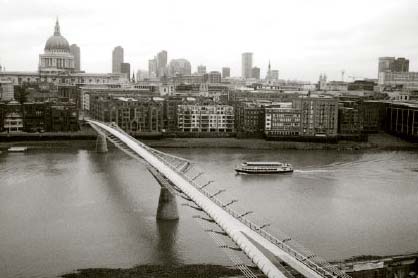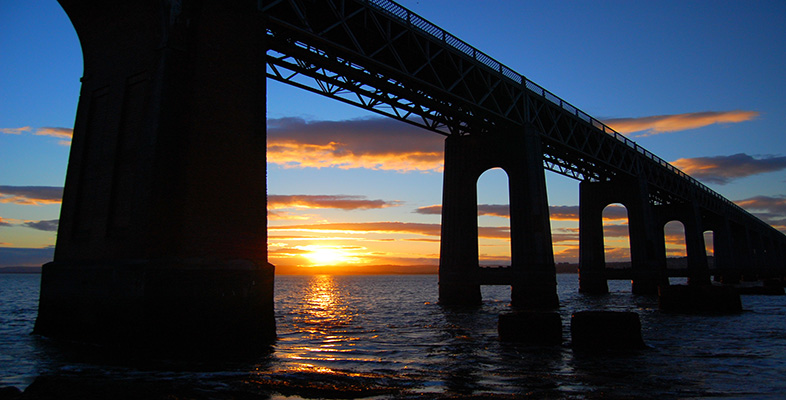6.3 Tacoma Narrows suspension bridge failure
Such over-design could not be sustained for long and bridge designers gradually pared back their margins of safety. There is elegance and economy in having the lightest structure compatible with function. But history has a habit of repeating itself.
In 1940 a new suspension bridge with a central span of 2800 feet was built over the Tacoma Narrows in the United States. It was soon noticed the bridge deck was prone to oscillate in certain winds. The vertical amplitude of the oscillations was as much as 5 feet, but the bridge was never closed to traffic.
Four months after the opening the deck went out of control in a 40 mph gale and literally shook itself to pieces (Figure 51). The bridge had been a victim of flutter, which was caused by the inadequate torsional stiffness of the bridge deck. The designers might have avoided disaster if they had realised the old chain pier in Brighton, England had collapsed for the very same reason way back in 1836.

The Tacoma Narrows suspension was in fact the longest freely suspended bridge that had ever been built at that time, and the potential for problems with its aerodynamics had not been tested by, for example, wind tunnel tests. A flat roadway can act as an aerofoil in a steady stream of air, but such a problem had not been considered.
Aerodynamic tests are now routinely performed for all large designs by using wind tunnels and models of the structures, well before construction starts. Nevertheless, real structures can sometimes show effects that are impossible to model. Pedestrians crossing a footbridge are impossible to consider in wind tunnel tests, but yet may affect the stability of the bridge being crossed.
This very problem has been encountered in several long footbridges erected recently in London and Paris. To the chagrin of users, the new millennium footbridge in London was closed when the bridge swayed uncontrollably from side to side shortly after being opened in 2000 (Figure 52).

It is a long thin cable-stayed bridge. Initial theories about the swaying have placed the blame on the pedestrians crossing the bridge at a time of a strong cross wind. Apparently, the visitors to the bridge were walking in unison as they crossed, so making the structure resonate. From Roman times, soldiers marching over bridges had been ordered to break step when crossing trestle bridges, but the authorities in the case of the millennium bridge have not yet considered advising users of this simple precaution.
Whether pedestrians actually are the cause of the problem remains unknown. Obviously, the purpose of the footbridge is to convey people from one side of the river to the other, and it would be foolish for civil engineers to deny that. From the facts available, it appears to be a failure of design and testing rather than being the fault of the users. After the installation of dampers and further testing, the bridge reopened in early 2002.
In the 1960s the new idea was the box-girder deck. For short spans this was simply supported on piers although longer spans could be suspended from central towers using cable stays. Problems started in June 1970 when a bridge over the river Cleddau in South Wales collapsed during erection, killing five people. As a span was being cantilevered out from a pier the bottom of the deck buckled and the whole span collapsed into the river. A similar incident occurred in November 1971 with a new bridge that was being built across the Rhine near Koblenz. Twelve people were killed in this mishap.
Meanwhile, in Australia, a major disaster had occurred at the West Gate bridge in Melbourne. In this incident a span had just been erected on its piers. The deck had been fabricated with an incorrect camber and kentledge (large blocks of concrete) had been lowered onto the span to deform the bridge into the correct shape. Not surprisingly this had raised a buckle in the top of the deck. High day time temperatures also aided buckling. In an attempt to remove the buckle the bolts were removed from one of the transverse splice joints in the top of the deck. This lunatic course of action weakened the bridge to the extent that the deck could no longer support the bending moment generated by the self-weight at mid span and the whole structure descended to the ground, killing 35. Again, full-scale experiments had established the limits of a new form of construction with disastrous results.
